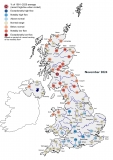Submitted by Steve Turner on
With an unsettled start and persistent frontal rain towards the end of the month, it was a wet September across much of the country. Over north-west Scotland, and parts of south-east England, however, rainfall totals were below average, and the UK enjoyed a dry spell mid-month that included some unseasonal warmth (27.7oC in Weybourne, Norfolk on the 22nd). During the last ten days, heavy rain caused travel disruption and localised flooding in England, Wales and Northern Ireland. Flows on many rivers in Wales and northern England were notably or exceptionally high for a second consecutive month, in contrast to notably and exceptionally low flows in parts of the south-east. Soil Moisture Deficits (SMDs) decreased markedly in response to the rainfall and by the end of the month soils were wetter than average across the country. Groundwater levels continued to decline at most sites, however, the overall situation was similar to that seen in August, with below normal or notably low levels in the Chalk, and mainly normal or above normal in other aquifers. Reservoir stocks remained healthy (with notable increases in Yorkshire and Severn Trent), except in the south-west and south-east (including the London reservoirs) where deficits relative to average remained. Whilst the outlook for water resources across much of the UK is healthy, sustained rainfall (following the wet start to October) is needed to return water resources in the south-east to normal over the winter half-year.
The full Hydrological Summary can be found here.



